“None of the ginkgo’s aesthetic qualities are all that different from those of other trees. I could just as easily wax poetic about the beauty of beech trees, or the majesty of ancient sugar pines. But I think that ginkgoes are just unusual enough for the occasional human to take notice of them. It’s not that any particular tree or breed of dog or varietal or rose is objectively superior to its peers, they just happen to be the creatures that momentarily capture our flickering attention. As soon as humans take open-hearted notice of anything in the natural world, we find reason to love it.”
― Unseen City: The Majesty of Pigeons, the Discreet Charm of Snails & Other Wonders of the Urban Wilderness
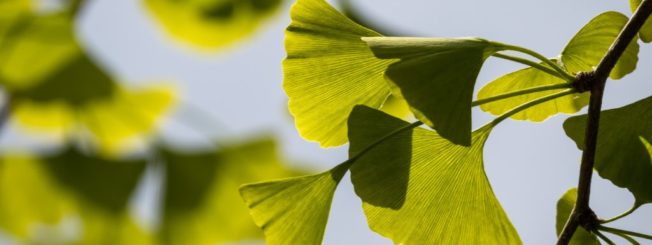
Tree Talk
Ginkgo biloba
A tree unlike others
The ginkgo tree is one-of-a-kind. Although there may have been several species in the past, the once-thought-extinct tree Ginkgo biloba is the only surviving species.
Have you ever seen a ginkgo tree growing? Unless it was added to your yard intentionally, it is unlikely there is one growing on its own. However, if you look around the landscapes in cities and parks, and even yards, you just may spot the fan-shaped leaves growing in the summer, or the bright yellow fans preparing to fall in autumn.
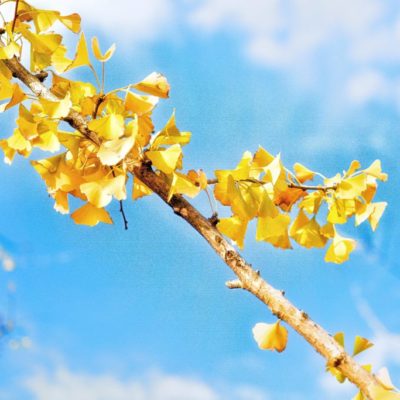
What’s the ginkgo’s story?
Ginkgo leaves have been discovered in fossils and ancient artwork. The tree was thought to be extinct, however, until 1691, when a German scientist named Engelbert Kaempfer found the tree growing in Japan.
Although not commonly found a few centuries ago, it had been saved and preserved around eastern monasteries and temples in Japan, as well as its native China.
Today, it has become more and more popular and widespread. Cities like to plant it for both the beautiful addition to the landscape as well as its tolerance of harsh conditions, like cold, hot, snow and ice, and even the salt used to melt ice in parking lots and on sidewalks.

The leaves turn a beautiful, golden yellow in the autumn.
(Source: pexels.com open source)
Nature in Real Life
While our focus is on plants and gardening, all of nature exists to teach us. Did you read the quote above? It’s complicated, and younger readers should look at it with an adult.
Some of these words may be new to you, too.
- Aesthetic: refers to artistic quality or beauty of something
- Wax poetic: a saying that refers to philosophical discussion about something
- Varietal: a specific kind of something, such as the pink miniature rose varietal
- Objective: refers to factual, not opinion-based “subjective”, things
Now think about this the next time you go outside and observe nature, whether in your front yard, backyard, or school playground: Is there something out there that you have never noticed before? What is it? How is it unique? What more could you learn about it?
Sometimes there is a lot to observe and learn about around us just by pausing and looking around. We see insects and plants we hadn’t noticed before. We see details on leaves or tree trunks that are unusual. We hear bird songs and insect noises that are new. We smell a flower we didn’t realize even had a scent.
The ginkgo tree hid for centuries in remote corners of the world, surviving but not always being noticed, and remaining a mystery to most of the world until an explorer and scientist found it. Now, because he found and shared it with others, we can also find reason to learn about and appreciate it.
Fun Facts About Ginkgo
Ginkgo biloba has both male and female trees. The female trees produce fruit, which is described as smelling very stinky when it is ripe.
The ginkgo tree is also known as the “maidenhair tree”.
In autumn, the leaves fall off at nearly the same time.
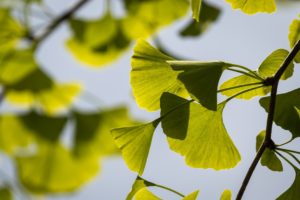
Inside that stinky fruit is the seed, a sort of nut that some people even eat!
Ginkgo trees are also resistant to insects and harmful fungi
Some cultures have made tea from ginkgo trees for centuries.
The leaves and branches contain substances that make them resistant to fire
Ginkgo trees grow very slowly but steadily, and live a very long time. If given a century or two to grow, they can become towering giants, over 100 feet tall.
The next time you find yourself in the city, or taking a family walk through a park, look around and see if you can spot any ginkgo trees!
Growing Ginkgo
A couple years ago, I bought a couple small ginkgo trees…
They arrived soon after, wrapped in plastic, with the roots stored in wood shavings and moist. There were a few leaves, but otherwise just two short twigs, not even two feet long.
I had picked out planters for my ginkgoes, a couple tall, deep, not-too-heavy, light gray containers. Both trees were planted, and a layer of stones was added to the top of each.
The trees stayed indoors at first. Their leaves stayed green for a while, but then one of them started to turn, quite suddenly, and fell. I checked the soil: perfect moisture, no signs of any other problems. I was a little disappointed, but still there was one healthy-appearing, green-leaved ginkgo remaining. The second one was moved to the garage.
A couple months later, as fall arrived, the second ginkgo’s leaves also yellowed and fell. It was fall, though, so I had some hope that this could just be a normal thing for it, even though its twin sat still in the garage, a single twig sticking up from the planter. I decided I would wait and see what happened, and ginkgo #2 remained in its planter, indoors.
Several months later, I returned home from work. Still the first ginkgo remained in the garage, mainly because I had not taken the time to do anything else with it – clearing the stones, soil, or tree. As I got out of my car and glanced at it, though, I was shocked: bright green leaves had suddenly appeared! It wasn’t dead after all! I quickly grabbed the planter and moved it back indoors.
It took a few more weeks for the second tree to also emerge from dormancy (and probably about the amount of time between when they first both lost their leaves). Soon I was back to having two happy, healthy ginkgo trees growing in their planters. When fall came again, they changed color and dropped their leaves together, heading into another season of dormancy to await the arrival of spring.
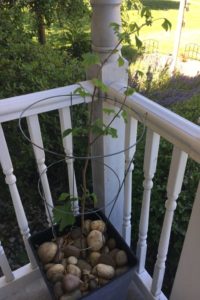
Ginkgo #1
After proudly re-emerging in the spring
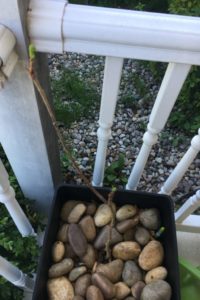
Ginkgo #2
A bit behind the first, but still healthy and happy
Now that I understand a bit more about ginkgo trees, I recognize that they are fairly easy to grow. They grow slowly, but they’re hardy and strong.
Ginkgo trees can be grown in a large planter, as long as they have space, and depth, and drainage to keep the roots from being too wet. They can also be planted into the yard as part of the landscape for most, as they’re designated as hardy to zones 4-9.
So far my ginkgo trees have remained in their planters. Perhaps at some point one of them will take up residence in the yard?
